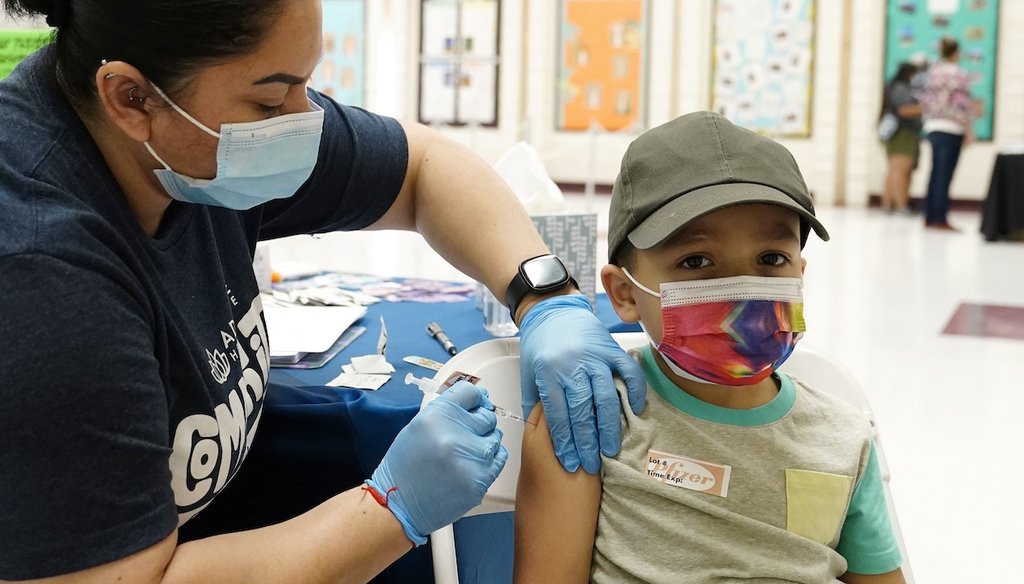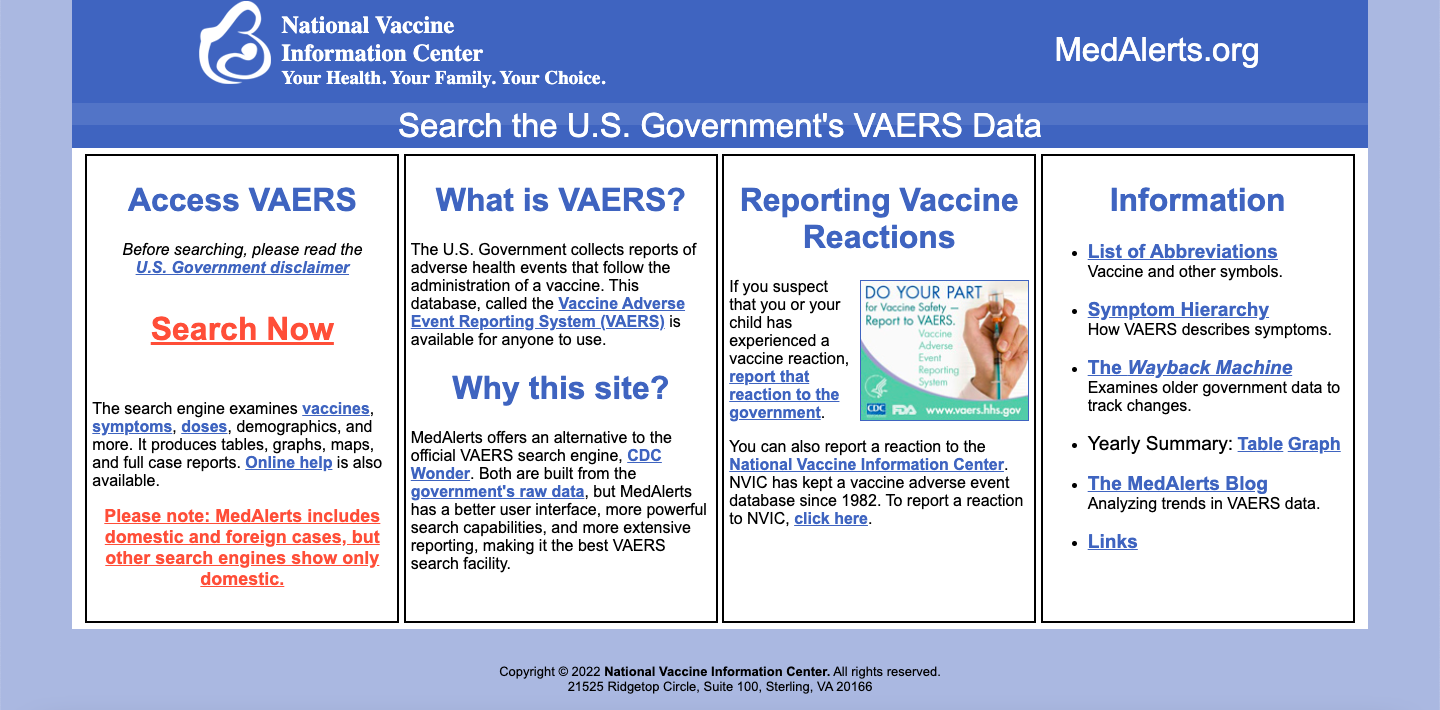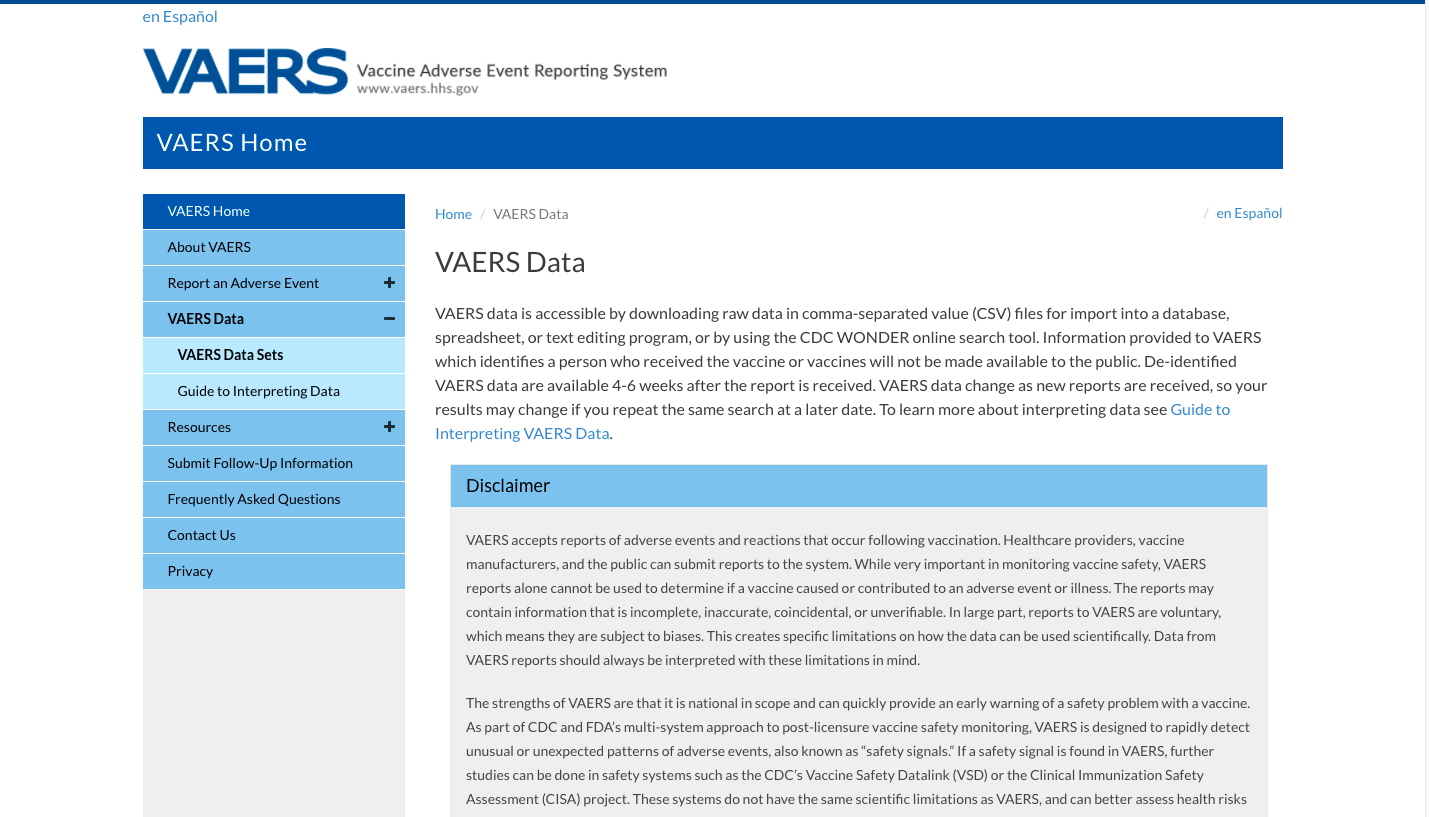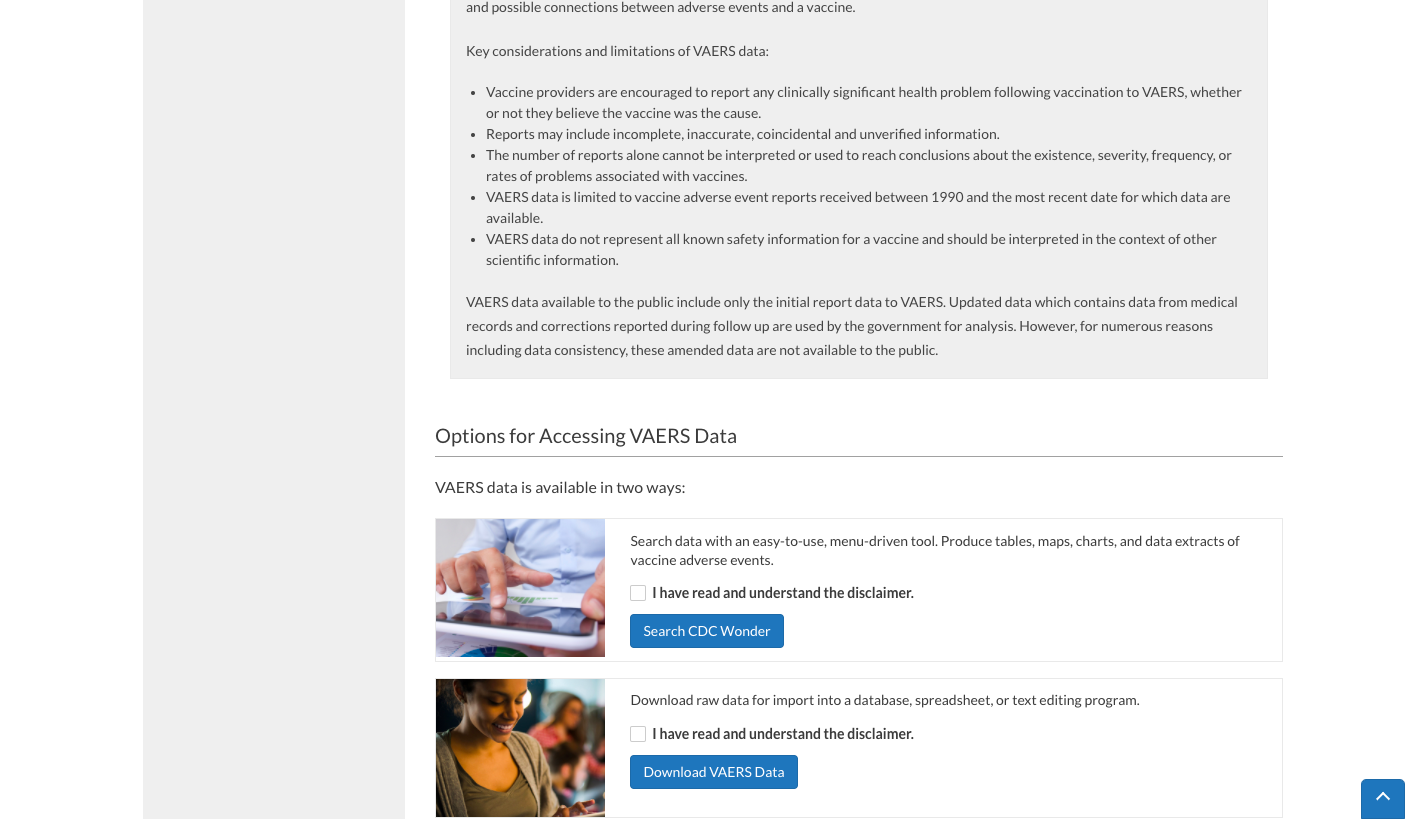Get PolitiFact in your inbox.

A nurse gives a child, aged 5, the first dose of the Pfizer vaccine on Nov. 6, 2021. This was the first time children aged 5 to 11 across the United States had the opportunity to get immunized against COVID-19. (AP)
If Your Time is short
-
MedAlerts, run by the anti-vaccine group National Vaccine Information Center, is an online search tool that allows users to sort through records from the Vaccine Adverse Event Reporting System, the federal repository of reports about things that happen to people after they are vaccinated.
-
MedAlerts draws on raw and limited VAERS reports, which can include information that is incomplete or inaccurate. These reports do not provide enough information to determine whether a vaccine caused a particular adverse event.
-
Users who go to MedAlerts can search through VAERS reports without ever reading a government disclaimer. There are inconspicuous links to those disclaimers, but unlike the CDC’s Wonder database, users on MedAlerts who don’t notice or click on the links won’t see the warnings about what they read.
During the public comment period of a U.S. Food and Drug Administration online advisory committee meeting on vaccines in September, Steve Kirsch took the virtual floor with a slide presentation and a troubling claim: that the Pfizer vaccine was killing five times as many people as it saved.
Kirsch is not a medical professional, scientist or vaccine expert. He’s a tech entrepreneur who has been promoting unproven treatments for COVID-19. Nonetheless, he has gained a following among vaccine skeptics with his alarming statistical claims about vaccine dangers, like the one about the killer Pfizer vaccine, which we rated Pants on Fire and the FDA roundly rejected.
Before his Twitter account was suspended this month for sharing multiple false vaccine claims, Kirsch had over 50,000 followers. His tweets helped draw traffic to his blog, where he has aired such claims as "they've now killed close to TWICE as many kids from the vaccine as have died from COVID" (also Pants on Fire).
How does he arrive at such conclusions? Kirsch said he relies on a mix of anecdotal evidence, mathematical calculations, and his analysis of raw numbers from the federal Vaccine Adverse Event Reporting System, which he accessed through an alternative gateway called MedAlerts.
It’s the same portal that has been used by others who have spread misinformation about the safety of COVID-19 vaccines, especially for children.
MedAlerts is an online search tool that allows users to sort through records from VAERS, the federal repository of reports about things that happen to people after they are vaccinated. Created in 2003, a few years before the Centers for Disease Control developed its own Wonder search tool, MedAlerts was a pioneering step in making VAERS reports more accessible and visible to the general public.
The MedAlerts site says that it has "a better user interface, more powerful search capabilities, and more extensive reporting," than CDC Wonder, "making it the best VAERS search facility." It notes, for example, that its results include by default foreign reports that CDC Wonder filters out.
But there are two important things to know about MedAlerts. First, it’s maintained by the National Vaccine Information Center, a nonprofit group that grew out of parents’ suspicions that vaccines were injuring or killing children. NVIC, which says it is dedicated to "preventing vaccine injuries and deaths through public education and advocacy," has made headlines in years past for promoting false information about vaccines and accepting nearly $3 million in donations from Dr. Joseph Mercola, an osteopathic physician known for sharing misinformation about the COVID-19 vaccines.
Second, MedAlerts ultimately draws on raw VAERS reports, with all their known limitations and flaws. As PolitiFact has reported, the VAERS reports can include information that is incomplete or inaccurate, and they do not provide enough information to determine whether a vaccine caused a particular adverse event. That means the search results from MedAlerts are just as vulnerable as CDC Wonder’s to misinterpretation by members of the public who are not trained to evaluate the information.
One key difference between the two search tools is how forthcoming they are about those limitations and flaws. CDC Wonder requires users to acknowledge a lengthy disclaimer before initiating a search, and repeats the full text of the disclaimer with the search results.
Among the key warnings that the CDC site lists in that disclaimer:
-
"Vaccine providers are encouraged to report any clinically significant health problem following vaccination to VAERS, whether or not they believe the vaccine was the cause."
-
"Reports may include incomplete, inaccurate, coincidental and unverified information."
-
"The number of reports alone cannot be interpreted or used to reach conclusions about the existence, severity, frequency, or rates of problems associated with vaccines."
On the NVIC’s MedAlerts, by contrast, you can search freely without ever seeing the disclaimer. There’s an inconspicuous link to the government disclaimer on the home page, and another link shown with the search results. But people who don’t notice or click on the link won’t see the warnings. This leaves little standing in the way between the public and raw, unverified data.
Throughout the pandemic, VAERS reports accessed through MedAlerts have been cited as a source for COVID-19 vaccine misinformation — especially related to risks to babies and children — that has been fact-checked by PolitiFact and other media outlets. For instance, a blog post from Health Impact News, citing tables sourced from MedAlerts, said almost 3,000 babies died in the womb after their mothers got the COVID-19 vaccines during pregnancy. An Instagram post falsely claimed babies whose mothers were vaccinated died after breastfeeding, based on an article that displayed a MedAlerts search result.
NVIC began in 1982 as Dissatisfied Parents Together, a group of parents who, after watching a TV documentary called "DPT: Vaccine Roulette," came to believe that their children were injured from the diphtheria, pertussis and tetanus vaccine. The report featured extensive footage of children who it said were brain damaged by the shots.
Medical experts that year denounced the documentary as inaccurate and said it dangerously distorted facts about the risk. But the report was a turning point in fueling parents’ suspicions that childhood vaccines could cause serious harm, triggering a wave of lawsuits against vaccine makers, more investigative reports and congressional hearings.
NVIC says it played a role in developing the National Childhood Vaccine Injury Act, which Congress passed in 1986. The law created a compensation program for families who claimed injury from vaccines, while limiting the legal exposure for drug makers.
"NVIC has monitored and reported on the implementation of the safety provisions in the (National Childhood Vaccine Injury) Act since it was enacted in November 1986," Barbara Loe Fisher, NVIC’s president and co-founder, told PolitiFact.
The law also led to the creation in 1990 of VAERS, the reporting system that the government would use to track suspected vaccine side effects, Seth Mnookin wrote in "The Panic Virus: A True Story of Medicine, Science, and Fear," a history of the anti-vaccine movement.
For years, VAERS reports were mostly invisible to the public. Until 2001, the public could access the reports only through a Freedom of Information Act request. In the early Internet era, the reports were digitized and made available for download from the VAERS website. Only in 2006 did the government develop CDC Wonder, a search tool for all of the agency’s data.
MedAlerts came before that. It was initially created by computer scientist Steven Rubin in 2003, before becoming subsumed by NVIC in 2005. The purpose of MedAlerts is to provide the public with a "user-friendly way to search the VAERS database," Fisher said.
MedAlerts presents users with a simpler interface for queries and search results displayed in neatly formatted, easy-to-read tables. Whether they’re accessed through MedAlerts or CDC Wonder, though, the underlying data are the same VAERS reports.
These are the reports that health professionals are encouraged — and in some cases required — to file when they encounter a patient with an adverse event occurring within a specified time after a vaccination. But anyone can submit a report, including parents and patients themselves.
And reports can be filed whether or not there’s reason to believe that the vaccine was the cause of the adverse event. With the COVID-19 vaccines, health providers are required to report any serious events, such as a birth defect, a life-threatening condition or one requiring hospitalization, regardless of whether the reporter thinks the vaccine caused the event.
That means the reports include instances of common, well-known side effects of some vaccines, such as nausea and fatigue. But they also include reports of more outlandish symptoms that have no plausible causal connection to the vaccines themselves, like "gunshot wound," and "screaming" — there were 144 reports of screaming at the time of our search. A new batch of reports becomes available every week, and the reports are not verified before they’re made accessible to the public.
This is why federal health officials and other experts consider the disclaimer so important for members of the general public who access VAERS reports.
When government researchers use and interpret VAERS reports, they are not drawing conclusions based on the numbers alone, but rather looking for patterns that warrant further study. As part of that process, they verify and cross-reference VAERS reports with other data sets that they have access to, including autopsy reports and medical records.
"Signals of rare adverse events associated with vaccines can be detected using VAERS, but these require investigation to determine if the vaccine actually caused the event," said Dr. William Moss, executive director of the International Vaccine Access Center at Johns Hopkins University. "Thus, VAERS can be hypothesis-generating, but does not provide evidence that a particular vaccine caused a specific adverse event. This is what makes interpretation of VAERS data open to misunderstanding and prone to facilitate the spread of misinformation."
The disclaimers built into CDC Wonder are provided to help reduce the risk of the data being misrepresented or misinterpreted, said Martha Sharan, a spokesperson for the CDC.
What concerns federal officials about MedAlerts is that it "republishes the CDC’s VAERS data without its appropriate disclaimers, which has resulted in misleading attributions of death and other adverse events to the COVID-19 vaccines," said Sharan.
Fisher, the NVIC president, noted that links to the government disclaimers are included on an NVIC description page and on the MedAlerts.org home page, as well as with MedAlerts search results. The disclaimer link on the MedAlerts home page appears in blue, just above a link that says "Search Now" — which is shown much larger, in red.
These hyperlinks direct the user to read the government disclaimer on the CDC site, without including a description of what the warning entails or why it is given. And MedAlerts users can bypass those links and head straight into searching for reports.
In order to search VAERS reports through the CDC Wonder tool, users must click an "I Agree" button or a checkbox acknowledging that they have read the full disclaimer. On MedAlerts.org, the disclaimer can be bypassed.
Kirsch, the tech entrepreneur, told PolitiFact that he believes NVIC’s website is "more comprehensive" and easier to use than the CDC’s portal, and he stands by using VAERS reports as a source for his claims about vaccine safety.
Kirsch acknowledged the existence of the CDC disclaimer, but questioned the substance of it.
"I think that the CDC has created the mirage that you can’t determine causality from the VAERS system," he said. "If people are telling you that these excess deaths were not caused by the vaccines, then what did cause these excess deaths?"
Kirsch claims to have uncovered evidence of hundreds of thousands of "excess deaths" attributable to the vaccine, citing, among other things, anecdotal reports of large increases in the number of reports filed to VAERS, extrapolations from limited data samples and small observational studies, and assumptions about the extent of underreporting to VAERS.
We’ve fact-checked such claims and found no clear scientific evidence to back the claim that the COVID-19 vaccines have caused a large number of deaths, and the FDA has dismissed Kirsch’s claims as "not based in science." Health experts warn against drawing conclusions based on raw statistical data from VAERS, because the COVID-19 vaccines are new, and the government has been encouraging people to submit reports as part of its evaluation, resulting in an especially large volume of reports after December 2020.
The FDA requires health care providers to report any death after COVID-19 vaccination to VAERS — even if it’s unclear whether the vaccine was the cause — and such deaths are still rare. The CDC says it has identified nine deaths that "have been caused by or were directly attributed" to a rare blood clot condition following the Johnson & Johnson/Janssen COVID-19 vaccination. Beyond that, it has reported no indications of vaccines causing excess deaths.
Clinical trials have shown the vaccines to be safe and effective, and some 547 million doses of the vaccines have been administered in the United States. Between Dec. 14, 2020, and Feb. 14, 2022, the CDC says, VAERS received 12,304 preliminary reports of death — from all causes — among people who got the vaccine, or fewer than one-hundredth of 1%. The CDC and the FDA, which jointly oversee VAERS, review those reports along with death certificates, autopsy reports and medical records. (COVID-19 itself has killed more than 900,000 in the U.S.)
Dr. Paul Offit, director of the Vaccine Education Center at the Children's Hospital of Philadelphia, explained to PolitiFact that four sets of data are needed to measure whether a vaccine has caused or contributed to an adverse event: vaccinated people who experienced that problem; vaccinated people who didn’t have it; unvaccinated people who had the problem; and unvaccinated people who didn’t.
"What (VAERS) gives you is one piece of information: You had a vaccine, had a side effect," he told PolitiFact in a 2021 interview. "That in no sense tells you whether or not the side effect was caused by the vaccine. So it’s a noisy system that frankly is more frightening than helpful."
Kirsch’s conclusions nonetheless illustrate an important point: The mere existence of the government’s disclaimer on VAERS cannot prevent people from ignoring it, or from drawing false or unsupported conclusions to share with the public. At best, the disclaimer creates a hurdle.
But it’s an important hurdle, said David Ropeik, former instructor at the Harvard School of Public Health, and a consultant and author on risk perception and communication.
Disclaimers aren’t really noticed when people jump online to look for the quick, easy answer, but firewalls like CDC Wonder’s "require you to get through all these caveats," Ropeik said. "And it’s less than completely honest to fail to have those caveats in place."
VAERS data was made public in an effort to create transparency about vaccine injury claims. But the fact that it’s being used as a platform for misinformation complicates the flow of accurate health information, experts said.
"We as a public health community need to acknowledge that vaccines do have side effects, and that rarely these can be severe," said Moss, from Johns Hopkins. "A system such as VAERS should help instill confidence that potential adverse events are being monitored, but the system is also prone to manipulation without the proper caveats. A site like MedAlerts seems to make misunderstanding easier."
The risk grows when the information is presented in statistical terms.
Even when public health agencies try to communicate the statistics as clearly as possible, those statistics can be poorly understood by the public, said Ropeik.
"Informatics, to the extent that they rely on numbers, are relying on a language that many people struggle with," said Ropeik. "And informatics that fail to relay the information in ways that account for people’s struggle with numbers, and people’s emotional risk perceptions, are banking on a rational response to the information that simply is not how we perceive anything."
PolitiFact researcher Caryn Baird contributed to this report.
Our Sources
PolitiFact, No evidence that the Pfizer vaccine causes deaths, Sept. 22, 2021
PolitiFact, FDA didn’t say Pfizer misled them about vaccine safety. The statement came from a public commenter, Feb. 17, 2022
Steve Kirsch’s newsletter, Feb. 6, 2022
PolitiFact, Contorted claim of children killed by COVID-19 vaccines is Pants on Fire, Dec. 21, 2021
National Vaccine Information Center, About National Vaccine Information Center, accessed Feb. 15, 2022
The Washington Post, A major funder of the anti-vaccine movement has made millions selling natural health products, Dec. 20, 2019
PolitiFact, Data does not show COVID-19 vaccine failure in England, Feb. 1, 2022
PolitiFact, Federal VAERS database is a critical tool for researchers, but a breeding ground for misinformation, May 3, 2021
Vaccine Adverse Event Reporting System home page, accessed Feb. 15, 2022
Reuters, Fact Check-No evidence COVID-19 vaccines have a "174 times higher" mortality rate in children than the virus, Oct. 21, 2021
PolitiFact, VAERS data misused to spread fears about vaccine’s impact on fetal health, Dec. 15, 2021
PolitiFact, No evidence infant died due to breast milk from vaccinated mother, Sept. 30, 2021
The Washington Post, TV Report on Vaccine Stirs Bitter Controversy, April 28, 1982
Vaccine Adverse Event Reporting System, Report an Adverse Event to VAERS, Feb. 21, 2022
National Vaccine Information Center, Vaccine Reporting Systems, Feb. 15, 2022
PolitiFact, No truth that VAERS system shows 6,000 "died because of" COVID-19 vaccines, Aug. 9, 2021
PolitiFact, FDA didn’t say Pfizer misled them about vaccine safety. The statement came from a public commenter, Feb. 17, 2022
Email interview with Barbara Loe Fisher, co-founder and president of the National Vaccine Information Center, Feb. 17, 2022
Email interview with Dr. William Moss, executive director of the International Vaccine Access Center at Johns Hopkins University, Feb. 18, 2022
Email interview with Martha Sharan, spokesperson for the Centers for Disease Control and Prevention, Feb. 18, 2022
Interview with Steve Kirsch, Feb. 18, 2022
Interview with Dr. Paul Offit, director of the Vaccine Education Center at the Children's Hospital of Philadelphia, April 16, 2021
David Ropeik, former instructor at the Harvard School of Public Health, and a consultant and author on risk perception and communication, Feb. 18, 2022





























